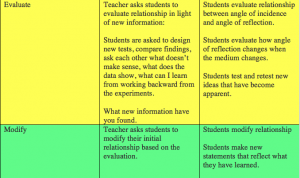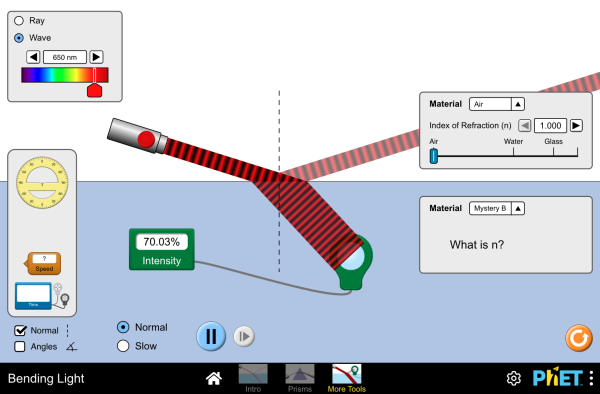Thoughts on Chemland:
I spent quite a while investigating the units on Chemland (General Chemistry Interactive Simulations). I found being able to change variables, predict outcomes and then seeing the outcomes very helpful. If my prediction was wrong I could test and retest my theories to help me build a new understanding of the concept. Chemland was interesting but the curriculum is far beyond anything that is ever tackled in my grade 6-8 classroom.
Seeing the interactive simulations sent me on a quest. I wanted to see what other science and math concept simulations were available for my grade levels. I have to admit I totally nerded out and spent way too much time “playing” with these simulations. Although I investigated a few simulation sites the one I found to be the most comprehensive, interactive and helpful was the PhET Interactive Simulations created by the University of Boulder Colorado.
The website is https://phet.colorado.edu/en/simulations/category/new is free and registering provides you with access to lessons and other teacher add-ons.
Thoughts on GEM and T-GEM
GEM (Generate, Evaluate, Modify) and T-GEM (which includes technology) is a cyclical approach to science education. The image below explains how T-GEM can be used in the science classroom.

I feel a valuable component of the T-GEM approach is that students are not given explicit information about a science topic and asked to regurgitate these facts, rather students are expected to compile information, and generate a statement about how factors are related. Students are then expected to test their ideas and discuss their findings with others and the teacher. Students test and retest their ideas to see if they were correct. Students are also able to change the parameters of the tests to see what would happen in any given scenario. Being able to change the parameters helps students solidify concepts in a new way. Khan 2007 states that Inquiry is associated with an array of positive student outcomes, such as growth in conceptual understanding, increased understanding of the nature of science, and development of research skills (Benford & Lawson, 2001; Marx et al., 2004; Metz, 2004; Roth, 1993; Wallace, Tsoi, Calkin, & Darley, 2004) (p 877).
Khan 2012 quotes the science teacher in the case study:
A lot of the kinds of things we do with computer simulation could be done with pieces of paper. The thing that’s better about the computer part of it is, you can do a lot more exploring, so [the computer simulation] gives [students] more control over what they’re going to look at, as opposed to if I give them a sheet of paper with numbers on it. It’s like I’m going to look at this information, I’m going to come to some conclusion, I’m going to look at some more information, an I’m going to test those conclusions…So when I throw up an overhead, I’m doing the exploring and they [the students] are explaining it. And that’s ok, but when it’s a simulation and they are choosing things, then they are doing the exploring much more (p 225-226).
This quote highlights how students can have control over their learning when using simulations and through the iterative process can dispel their own misconceptions about scientific concepts.
Challenging concept in your field: Light Snell’s Law, Reflection and Refraction
- State how you know it is a challenge for students (eg. practice, student tests, and research on misconceptions).
One of the challenging science units I have taught is Light (including Snell’s Law, Reflection and Refraction).
I know that Light is a difficult unit for students because it involves both scientific and mathematical concepts. Students voice their difficulty with the concepts during lessons and experiments. Often traditional test scores have been quite low and finally, students are not able to talk about or demonstrate their understanding of the concepts with any degree of certainty.
Plan a 3-step T-GEM cycle for this challenging concept in your field. Use a visual to assist in showing the plan.
T-GEM Approach to a science unit on Light
One of the challenging science units I have taught is Light (including Snell’s Law, Reflection and Refraction).
I know that Light is a difficult unit for students because it involves both scientific and mathematical concepts. Students voice their difficulty with the concepts during lessons and experiments. Often traditional test scores have been quite low and finally, students are not able to talk about or demonstrate their understanding of the concepts with any degree of certainty.
Plan a 3-step T-GEM cycle for this challenging concept in your field. Use a visual to assist in showing the plan.
T-GEM Approach to a science unit on Light



Select an appropriate digital technology that may work for this concept.
Below is a link to the simulation I chose to accompany this unit. Just click the image.
References:
Khan, S. (2007). Model-based inquiries in chemistry. Science Education, 91(6), 877-905.
Khan, S. (2012). A Hidden GEM: A pedagogical approach to using technology to teach global warming. The Science Teacher, 79(8). This article was written about T-GEM with middle-schoolers.
https://phet.colorado.edu/en/simulation/legacy/bending-light

Thank you for the link to the PhET site. I too struggled with some of the Chemlab simulations as many were way above my pay grade. I have spent a lot of time searching the internet for appropriate science and math simulations to help engage my 6-8 students and to provide a clearer understanding of the concepts being taught. The simulations on the PhET site are quite varied and are classified by grades as well as subject, which makes it fairly easy to find something pertinent to the subject. I know the students will enjoy being able to change the variables in the simulation to test out the different outcomes, which would not necessarily be available to them in a regular middle school classroom.
PhET conveniently provides folks with lesson plans that are easily adaptable to suit individual classrooms. I have “borrowed” three so far! I am a fan of not reinventing wheels. ~Dana 🙂
Hi Dana,
Yes, I noticed that there are several lessons and ideas from other educators that accompany the simulations, although I have not had time to review any as of yet, I am excited to look at them. Reinventing the wheel in a job that has us spinning so many wheels at once is just poor time management in my opinion. If something exists that does exactly what I need it to do I use it, if I want to go in another direction I tweak it, if I can’t find what I am looking for I get excited to see what I can create.
Catherine
This is great – thanks for the PhET Simulations link, Catherine! I was excited to see how many were available for elementary and could see myself using a few of them with my grade 3’s! I agree with you that I think simulations allow far more opportunities for students to explore and make their own inquiries. This can save time, money for supplies, and could provide a ‘safe’ environment for students to try out their wonders that they may be shy to ask or say in front of others. While I do not think simulations should replace hands on learning and experiences in the classroom I do think they have their place in providing meaningful learning opportunities for students.
Allison
Hi Catherine,
I enjoyed reading your post and thought you did a great job of integrating the T-GEM model into your unit on light. I like that while you provide students with necessary vocabulary, you do not simply give them the information they will need to know about reflection/refraction, but have them generate ideas to create their own hypotheses regarding relationships and theories, as well as introducing variables such as the angle of incidence and changes in medium. I also like that you ask students to apply their newly acquired knowledge to a “new scenario” which should help to develop the idea that concepts taught in science do not belong only to one scenario learned within the science classroom, but can be applied to multiple scenarios throughout our lives. The interactive simulation you chose gave great examples for students to experiment with – I thought the addition of “Mystery A” and “Mystery B” materials in the “Intro” section was neat! My favourite was the “Prisms” application which I think would really engage students as they are given the opportunity to experiment with different variables, like environment, beam (loved the “rainbow” which I can see drawing some of my girls in – not trying to be stereotypical, it’s just the fact of the matter), and objects, as well as having the ability to add reflection/protractor. I also like the fact that the “More Tools” application would appeal to learners who need an additional challenge. The varying levels of inquiry that your simulation offered reminded me of Shelley Moore’s (2014) “UDL Planning Triangle” (also referred to as “Planning Pyramid” in the “Templates” section of her site) as it offers simulations to engage students at all levels (“Goals for ALL,” “Goals for MOST,” “Goals for FEW”). The necessary curriculum concepts are accessible for all learners, but there is the potential for extended goals to be set to challenge those students who need “more”.
References:
Moore. S. (2014). UDL planning triangle (or “Planning Pyramid”). Blogsomemoore: Teaching and Empowering ALL Students. Retrieved from https://blogsomemoore.com/shout-outs/templates/
Catherine, thank you for the T-GEM sequence using the table where we can see your guiding questions and student cognitive processes specific to the subject. The quotation from the paper is one that resonated with your ideas on your practice and the role of exploration by students. Thank you for providing the link to the PhET simulations. They are a great choice for your lesson on Snell’s law. (We will be exploring the PhET sims some more in Module C too). Interestingly, the PhET group and I co-authored a book on simulations (I wrote a chapter on the future of simulation design and they, on Animation or Simulation: Investigating the Importance of Interactivity for Learning Solubility Equilibria). Where do you envision the simulation on light being utilized within your GEM phases as outlined? Thank you, Samia
Hi Samia,
I would incorporate the simulations at the end of the generate portion of the T-GEM format. Students would have improved their vocabulary, developed a basic understanding of concepts and then would be able to try the simulations. Once the basic simulations have been attempted students would be encouraged to try manipulating the variables (I would include here a predict phase- for example, the student would write down their modification and the expected result, test the changed variable and see if their hypothesis was correct. If the student had made an incorrect hypothesis they would have the opportunity to go back and try all simulations to see where they went off track. If misconceptions were still present it may be time for some simulations where the teacher is present and the student had to explain their thinking. This would provide the educator with a deeper understanding of why the misconception exists and how to correct it.)
Catherine